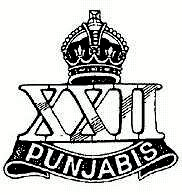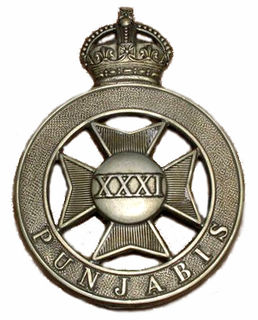
The 2nd Queen Victoria's Own Rajput Light Infantry, commonly shortened to 2nd Rajputs, was a regiment of the British Indian Army. Raised in 1798, it was amalgamated with five other Rajput regiments in 1922.

The Bengal Army was the army of the Bengal Presidency, one of the three presidencies of British India within the British Empire.

The regiments of Bengal Native Infantry, alongside the regiments of Bengal European Infantry, were the regular infantry components of the East India Company's Bengal Army from the raising of the first Native battalion in 1757 to the passing into law of the Government of India Act 1858. At this latter point control of the East India Company's Bengal Presidency passed to the British Government. The first locally recruited battalion was raised by the East India Company in 1757 and by the start of 1857 there were 74 regiments of Bengal Native Infantry in the Bengal Army. Following the Mutiny the Presidency armies came under the direct control of the United Kingdom Government and there was a widespread reorganisation of the Bengal Army that saw the Bengal Native Infantry regiments reduced to 45.

The Madras Army was the army of the Presidency of Madras, one of the three presidencies of British India within the British Empire.
The 1st Brahmans was an infantry regiment of the British Indian Army. It was raised at Oudh by Captain T Naylor in 1776 for service in the army of Nawab Wazir of Oudh, and was known as the Nawab Wazir's Regiment. It was transferred to the East India Company in 1777. In 1922, it was designated as the 4th Battalion 1st Punjab Regiment. The regiment was disbanded in 1931.
The 16th Rajputs was an infantry regiment of the Bengal Army and later of the united British Indian Army. It can trace its origins to 1857, during the Indian Mutiny when it was formed from men of the 13th, 48th and 71st Bengal Native Infantry regiments that remained loyal to the British. Named The Lucknow Regiment they were responsible for guarding the Bailey Gate in the Lucknow Residency. Over the years they were known by a number of different titles the 16th Bengal Native Infantry in 1861, the 16th Bengal Native Infantry 1864, the 16th Bengal Infantry 1885, the 16th Rajput Bengal Infantry 1897, the 16th Rajput Infantry 1901 and finally after the Kitchener reforms of the Indian Army the 16th Rajputs.

The 29th Punjabis was an infantry regiment of the British Indian Army. It was raised in 1857, as the 21st Regiment of Punjab Infantry. It was designated as the 29th Punjabis in 1903 and became 10th (Training) Battalion of 15th Punjab Regiment in 1922. In 1943, it was converted into the 15th Punjab Regimental Centre. In 1947, the 15th Punjab Regiment was allocated to the Pakistan Army. In 1956, the 1st, 14th, 15th and 16th Punjab Regimental Centres where amalgamated to form the Punjab Regimental Centre.
The 1st Regiment of Bengal Native Infantry refers to the Bengal Native Infantry unit that mutinied in 1857.
The 10th Jats were an infantry regiment of the British Indian Army. They could trace their origins to 1823, when they were known as the 1st Battalion, 33rd Bengal Native Infantry. Over the years they became known by a number of different titles. The 65th Bengal Native Infantry 1824–1861, the 10th Bengal Native Infantry 1861–1885, the 10th Bengal Infantry 1885–1897, the 10th Jat Bengal Infantry 1897–1901, the 10th Jat Infantry 1901–1903 and finally in 1903 the 10th Jats.
The 17th Infantry was an infantry regiment of the Bengal Army, later of the united British Indian Army. It was formed at Phillour in 1858 by Major J. C. Innes from men of the 3rd, 36th and 61st Bengal Native Infantry regiments who remained loyal to the British East India Company during the Indian Mutiny, and designated The Loyal Purbiah Regiment.
The 2nd Regiment of Bengal Native Infantry was a Commonwealth infantry unit that mutinied from command in 1857.
The 4th Regiment of Bengal Native Infantry was formed under that name in 1824. It took part in the Indian Rebellion of 1857.
The 18th Regiment of the Bengal Native Infantry was a unit of the Bengal Native Infantry that was formed in 1776, then mutinied in 1857 and was disbanded.
The 21st Punjabis were an infantry regiment of the British Indian Army. It was raised in 1857, as the 11th Regiment of Punjab Infantry. It was designated as the 21st Punjabis in 1903 and became 10th (Training) Battalion of 14th Punjab Regiment in 1922. In 1943, it was converted into the 14th Punjab Regimental Centre. In 1947, the 14th Punjab Regiment was allocated to the Pakistan Army. In 1956, the 1st, 14th, 15th and 16th Punjab Regimental Centres where amalgamated to form the Punjab Regimental Centre.

The 22nd Punjabis was an infantry regiment of the British Indian Army. It was raised in 1857, as the 11th Regiment of Punjab Infantry. It was designated as the 22nd Punjabis in 1903 and became 3rd Battalion 14th Punjab Regiment in 1922. In 1947, it was allocated to the Pakistan Army, where it continues to exist as 7th Battalion The Punjab Regiment.

The 27th Punjabis were an infantry regiment of the British Indian Army. It was raised in 1857, as the 19th Regiment of Punjab Infantry. It was designated as the 27th Punjabis in 1903 and became 3rd Battalion 15th Punjab Regiment in 1922. In 1947, it was allocated to the Pakistan Army, where it continues to exist as 11th Battalion The Punjab Regiment.

The 30th Punjabis were an infantry regiment of the British Indian Army. It was raised in 1857, as the 22nd Regiment of Punjab Infantry. It was designated as the 30th Punjabis in 1903 and became 1st Battalion 16th Punjab Regiment in 1922. In 1947, it was allocated to the Pakistan Army, where it continues to exist as 13th Battalion The Punjab Regiment.

The 31st Punjabis was an infantry regiment of the British Indian Army. It was raised in 1857, as Van Cortlandt's Levy. The regiment was designated as the 31st Punjabis in 1903 and became 2nd Battalion 16th Punjab Regiment in 1922. In 1947, it was allocated to the Pakistan Army, where it continues to exist as 14th Battalion The Punjab Regiment.

The 33rd Punjabis was an infantry regiment of the British Indian Army. It was raised in 1857, as the Allahabad Levy. It was designated as the 33rd Punjabis in 1903 and became 3rd Battalion 16th Punjab Regiment in 1922. In 1947, it was allocated to the Pakistan Army, where it continues to exist as 15th Battalion The Punjab Regiment.

The 45th Rattray's Sikhs was an infantry regiment of the British Indian Army. They could trace their origins to the 1st Bengal Military Police Battalion raised in April 1856, at Lahore, by Captain Thomas Rattray originally consisting of a troop of 100 cavalry and 500 infantry. The initial class composition of the troops was 50% Sikhs and 50% Dogras, Rajputs and Mussulmans (Muslims) from the Punjab and the North-West Frontier. It is said that he went through the villages challenging men to wrestle with him on the condition that they had to join up. Whatever the case, the regiment was raised and trained and developed as an elite corps, which soon saw action in Bihar in the Sonthal 'purghanas'. After sterling service in Bihar, Bengal and Assam, and during the 1857 Mutiny, the cavalry portion was eventually disbanded in 1864 and the infantry section was taken into the line of Bengal Native Infantry as the '45th Native Regiment of Infantry'.








